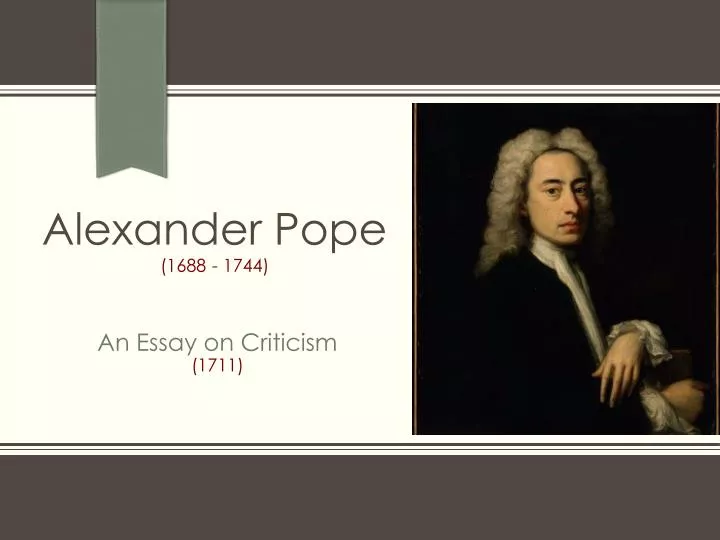

An Essay on Criticism (1711)
Feb 21, 2014
610 likes | 2.39k Views
Alexander Pope (1688 - 1744). An Essay on Criticism (1711) . Late 17 th century – Early 18 th century. Augustan Age Neo-Classical Age The Age of Reason. Alexander Pope. Alexander Pope (c. 1727), an English poet best known for his
Share Presentation
- heroic couplet john dennis
- ev'ry page religion
- soulwith spirits
- arifi rawan al
- morals criticks

Presentation Transcript
Alexander Pope (1688 - 1744) An Essay on Criticism (1711)
Late 17th century – Early 18th century • Augustan Age • Neo-Classical Age • The Age of Reason
Alexander Pope Alexander Pope (c. 1727), an English poet best known for his Essay on Criticism, The Rape of the Lock and The Dunciad Born: 21 May 1688 London Died: 30 May 1744 (aged 56) Birthand lineage Life and Education His work and contribution to literature
An Essay on Criticism Structure Written in heroic couplets. Written in the Horatian mode. Concerned with the writers and critics behave in the new literary commerce. Covers a range of good criticism and advice. Represents many of the chief literary ideals of Pope's age. It is divided into 3 parts: thesis, antithesis, and synthesis. It explains what a bad critic is? and what a good critic is?
Part I (1-200) Thesis - it presents a problem
Part I 'Tis hard to say, if greater Want of SkillAppear in Writing or in Judging ill,But, of the two, less dang'rous is th' Offence,To tire our Patience, than mis-lead our Sense:Some few in that, but Numbers err in this,Ten Censure wrong for one who Writes amiss;A Fool might once himself alone expose,Now One in Verse makes many more in Prose.
Part I Authors are partial to their Wit, 'tis true, But are not Criticks to their Judgment too? Some have at first for Wits, then Poets past,Turn'd Criticks next, and prov'd plain Fools at last; Nature to all things fix'd the Limits fit,And wisely curb'd proud Man's pretending Wit:
Part I First follow NATURE, and your Judgment frameBy her just Standard, which is still the same:Unerring Nature, still divinely bright,One clear, unchang'd and Universal Light,Life, Force, and Beauty, must to all impart,At once the Source, and End, and Test of ArtArt from that Fund each just Supply provides,Works without Show, and without Pomp presides:In some fair Body thus th' informing SoulWith Spirits feeds, with Vigour fills the whole, Each Motion guides, and ev'ry Nerve sustains;It self unseen, but in th' Effects, remains.
Part I You then whose Judgment the right Course wou'd steer,Know well each ANCIENT's proper Character,His Fable, Subject, Scope in ev'ry Page,Religion, Country, Genius of his Age:Without all these at once before your Eyes,Cavil you may, but never Criticize.Be Homer's Works your Study, and Delight,Read them by Day, and meditate by Night,Thence form your Judgment, thence your Maxims bring,And trace the Muses upward to their Spring;
Part II (203-561)Antitheses - what makes a bad critic?
Part II Of all the Causes which conspire to blindMan's erring Judgment, and misguide the Mind,What the weak Head with strongest Byass rules,Is Pride, the never-failing Vice of Fools.Whatever Nature has in Worth deny'd,She gives in large Recruits of needful Pride;For as in Bodies, thus in Souls, we findWhat wants in Blood and Spirits, swell'd with Wind;Pride, where Wit fails, steps in to our Defence,And fills up all the mighty Void of Sense!
Part II A little Learning is a dang'rous Thing;Drink deep, or taste not the Pierian Spring:There shallow Draughts intoxicate the Brain,And drinking largely sobers us again.
Part II A perfect Judge will read each Work of WitWith the same Spirit that its Author writ,Survey the Whole, nor seek slight Faults to find,Where Nature moves, and Rapture warms the Mind;
Part II But most by Numbers judge a Poet's Song,And smooth or rough, with them, is right or wrong;In the bright Muse tho' thousand Charms conspire,Her Voice is all these tuneful Fools admire,Who haunt Parnassus but to please their Ear,Not mend their Minds; as some to Church repair,Not for the Doctrine, but the Musick there.
Part II These Equal Syllables alone require,Tho' oft the Ear the open Vowels tire,While Expletives their feeble Aid do join,And ten low Words oft creep in one dull Line,While they ring round the same unvary'd Chimes,With sure Returns of still expected Rhymes. Avoid Extreams; and shun the Fault of such,Who still are pleas'd too little, or too much.
Part III (562-the end)Synthesis - celebration of good critics.
Part III LEARN then what MORALS Criticks ought to show,For 'tis but half a Judge's Task, to Know.'Tis not enough, Taste, Judgment, Learning, join;In all you speak, let Truth and Candor shine:That not alone what to your Sense is due,All may allow; but seek your Friendship too. Be silent always when you doubt your Sense;And speak, tho' sure, with seeming Diffidence:
Part III Horace still charms with graceful Negligence,And without Method talks us into Sense,Will like a Friend familarly conveyThe truest Notions in the easiest way.He, who Supream in Judgment, as in Wit,Might boldly censure, as he boldly writ,Yet judg'd with Coolness tho' he sung with Fire;His Precepts teach but what his Works inspire.Our Criticks take a contrary Extream,They judge with Fury, but they write with Fle'me:Nor suffers Horace more in wrong TranslationsBy Wits, than Criticks in as wrong Quotations.
Part III The Rules, a Nation born to serve, obeys,And Boileau still in Right of Horace sways.But we, brave Britons, Foreign Laws despis'd,And kept unconquer'd and unciviliz'd,Fierce for the Liberties of Wit, and bold,We still defy'd the Romans as of old.
Part III This humble Praise, lamented Shade! receive,This Praise at least a grateful Muse may give!The Muse, whose early Voice you taught to Sing,Prescrib'd her Heights, and prun'd her tender Wing,(Her Guide now lost) no more attempts to rise,But in low Numbers short Excursions tries:Content, if hence th' Unlearned their Wants may view,The Learn'd reflect on what before they knew:Careless of Censure, not too fond of Fame,Still pleas'd to praise, yet not afraid to blame,Averse alike to Flatter, or Offend,Not free from Faults, nor yet too vain to mend.
The rules of taste. • The rules of nature. • The moral qualities and virtues of the ideal critic. Themes
Tune: Pope's tone in this poem was both critical and satirical but also along with a sense of humor. Alexander Pope was good at satirizing in a witty way. Symbol: Muse is the symbol of beautiful melodies. People at that time judged a poem only by it's sounds so the writer use Muse as a symbol to be pleasant to listen to.
The Achievements of Pope in this essay: It summarizes the ideas and aspects of all schools. It introduces the ideas of Neo-Classicism. The main ideas in the essay: Writing should follow a very specific order. Nature is the main source of inspiration. Pope searches for a balance between writing a good work with following the rules and writing according to a very specific and organized way. He introduces the idea of finding a golden mean. Pope also talks about the development of the importance of poetry. This poem is a representation of the idea of eclecticism. It has opponent from different sources. He borrows his ideas from different critics like Dryden and Longinus. Pope has a very bad opinion of contemporary critics. He is a very great satirist. This poem contains many examples of epigrammatism, which is a saying, later on, people use as proverbs.
Fill in the blanks: Heroic Couplet John Dennis 2- This work An Essay on Criticism was famously and fiercely attacked by…………………. Augustan 3- Alexander Pope was related to ……………. School / Period 1-Alexander Pope wrote his poem in a type of rhyming verse called ……………………..
Haifa Al-Dhuwayhi Noura Al-Arifi Rawan Al-Shehri Latifa Al-Shebib Jumana Al-Mutairi Marwa
- More by User

Literary Criticism: An Overview
Literary Criticism: An Overview. Critical Approaches to Literature . Dr, Amy Berry SMSU February 1, 2012. Literary criticism gives us a window into a work of literature It gives us a particular way of understanding the text from a specific viewpoint.
337 views • 16 slides

David Hume on miracles
David Hume on miracles. The modern background: David Hume (Scottish, 1711-1776) on miracles ( An Inquiry Concerning Human Understanding , 1748) Biographical notes. David Hume on miracles.
448 views • 9 slides

Is your essay an essay?
Is your essay an essay?. I don’t know. . What is an Essay?. I don’t know. Okay. I'll try:. What does it look like? What does it contain? How many paragraphs? Who told you/taught you this? Have you received conflicting info on how to write an essay?
522 views • 22 slides
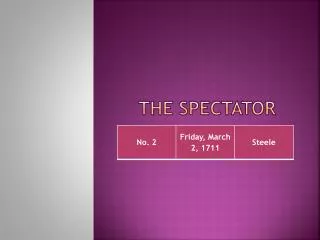
THE spectator
THE spectator . Richard Steele. No. 2 Friday, March 2, 1711.
383 views • 18 slides

Persuasion Essay An essay with an attitude!
Persuasion Essay An essay with an attitude!. It’s a matter of opinion~ supported by research!. How do we persuade our reader?. Arguments based on facts and RESEARCH Arguments that respect other view points Arguments made with persuasive techniques ~ ethos ~ pathos ~ logos.
235 views • 8 slides

Y.1711 & LSP-PING draft-allan-y1711-and-lsp-ping-00.txt PWE3_WG@IETF 56
Y.1711 & LSP-PING draft-allan-y1711-and-lsp-ping-00.txt PWE3_WG@IETF 56. Dave Allan Nortel Networks. Motivations. Highlight the complementary nature of Y.1711 and LSP-PING Draft is purely informational. Y.1711. General attributes
214 views • 9 slides
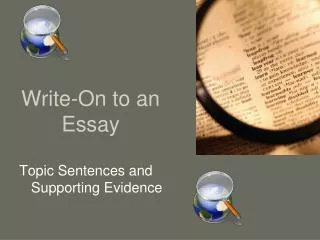
Write-On to an Essay
Write-On to an Essay. Topic Sentences and Supporting Evidence. What is a topic sentence?. A sentence that communicates the meaning of the paragraph. A topic sentence develops one major point and gives unity to the paragraph. A topic sentence links to the thesis to signify which part of
433 views • 26 slides
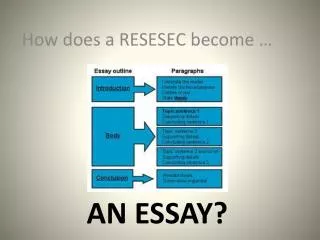
How does a RESESEC become …. An Essay?. RESESEC. A RESESEC is just a mnemonic device for h elping you to write an answer to an OPEN RESPONSE question. -- in class this year -- in class (beginning of next year) -- on MCAS. How many paragraphs?. How many paragraphs are in an essay?.
281 views • 10 slides
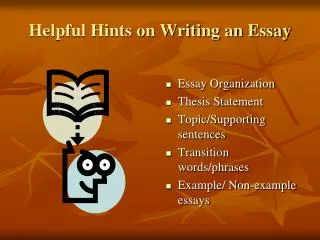
Helpful Hints on Writing an Essay
Helpful Hints on Writing an Essay. Essay Organization Thesis Statement Topic/Supporting sentences Transition words/phrases Example/ Non-example essays. Organizing an Essay. When organizing an essay, ask yourself these questions… Is there a clearly stated purpose/objective?
368 views • 18 slides

Write-On to an Essay. Taking the first steps to writing an essay. Step 1- Deconstruct the prompt. Look at the verb in the prompt- determine what the prompt is asking you do. If it helps you, turn the prompt into a question. Circle key words and identify topic (s) to address.
429 views • 32 slides

Spectator No . 115. Thursday, July 12, 1711
Spectator No . 115. Thursday, July 12, 1711. No. 115. Thursday, July 12, 1711. '... Ut sit Mens sana in Corpore sano.' Juv. "A sound mind in a healthy body.". No. 115. Thursday, July 12, 1711.
484 views • 25 slides

Literary Criticism: An Overview. Critical Approaches to Literature. Dr, Amy Berry SMSU February 1, 2012. Literary criticism gives us a window into a work of literature It gives us a particular way of understanding the text from a specific viewpoint.
439 views • 16 slides
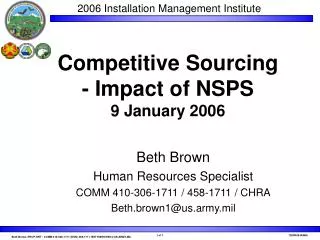
Competitive Sourcing - Impact of NSPS 9 January 2006
Competitive Sourcing - Impact of NSPS 9 January 2006. Beth Brown Human Resources Specialist COMM 410-306-1711 / 458-1711 / CHRA [email protected]. Intended Audience:
413 views • 34 slides

Spectator. No. 172 Monday, September 17, 1711.
342 views • 21 slides
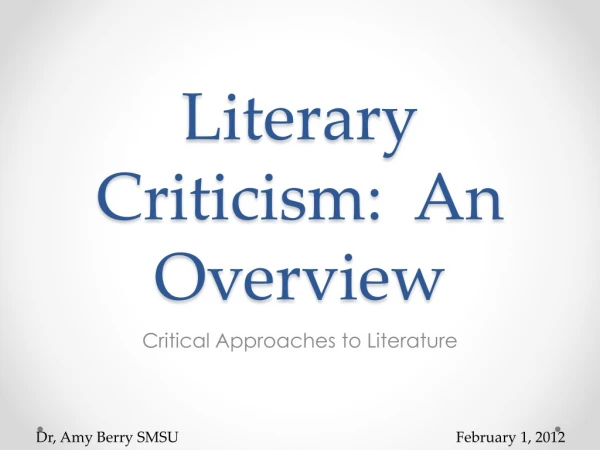
170 views • 16 slides
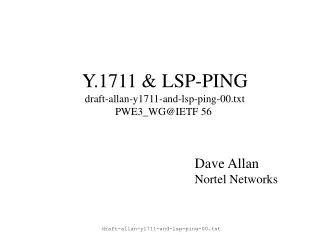
128 views • 9 slides

Tips on Writing an Opinion Essay
Follow the tips on writing an opinion essay and improve your essay writing. Looking for 'write my essay' requests? Visit https://www.cheapestessay.com/write-my-essay now!
211 views • 8 slides

An Essay on Criticism Summary & Analysis by Alexander Pope
- Line-by-Line Explanation & Analysis
- Poetic Devices
- Vocabulary & References
- Form, Meter, & Rhyme Scheme
- Line-by-Line Explanations
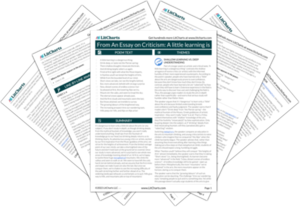
Alexander Pope's "An Essay on Criticism" seeks to lay down rules of good taste in poetry criticism, and in poetry itself. Structured as an essay in rhyming verse, it offers advice to the aspiring critic while satirizing amateurish criticism and poetry. The famous passage beginning "A little learning is a dangerous thing" advises would-be critics to learn their field in depth, warning that the arts demand much longer and more arduous study than beginners expect. The passage can also be read as a warning against shallow learning in general. Published in 1711, when Alexander Pope was just 23, the "Essay" brought its author fame and notoriety while he was still a young poet himself.
- Read the full text of “From An Essay on Criticism: A little learning is a dangerous thing”
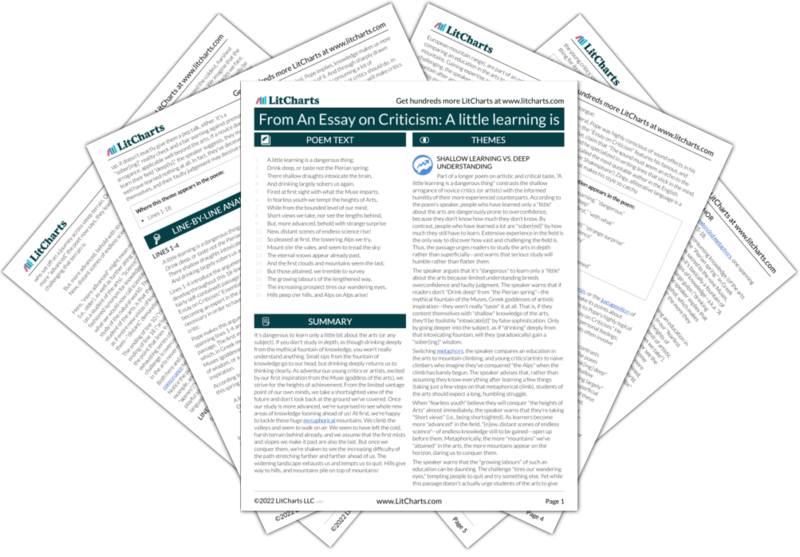
The Full Text of “From An Essay on Criticism: A little learning is a dangerous thing”
1 A little learning is a dangerous thing;
2 Drink deep, or taste not the Pierian spring:
3 There shallow draughts intoxicate the brain,
4 And drinking largely sobers us again.
5 Fired at first sight with what the Muse imparts,
6 In fearless youth we tempt the heights of Arts,
7 While from the bounded level of our mind,
8 Short views we take, nor see the lengths behind,
9 But, more advanced, behold with strange surprise
10 New, distant scenes of endless science rise!
11 So pleased at first, the towering Alps we try,
12 Mount o'er the vales, and seem to tread the sky;
13 The eternal snows appear already past,
14 And the first clouds and mountains seem the last;
15 But those attained, we tremble to survey
16 The growing labours of the lengthened way,
17 The increasing prospect tires our wandering eyes,
18 Hills peep o'er hills, and Alps on Alps arise!
“From An Essay on Criticism: A little learning is a dangerous thing” Summary
“from an essay on criticism: a little learning is a dangerous thing” themes.

Shallow Learning vs. Deep Understanding
- See where this theme is active in the poem.
Line-by-Line Explanation & Analysis of “From An Essay on Criticism: A little learning is a dangerous thing”
A little learning is a dangerous thing; Drink deep, or taste not the Pierian spring: There shallow draughts intoxicate the brain, And drinking largely sobers us again.

Fired at first sight with what the Muse imparts, In fearless youth we tempt the heights of Arts, While from the bounded level of our mind, Short views we take, nor see the lengths behind,
But, more advanced, behold with strange surprise New, distant scenes of endless science rise!
Lines 11-14
So pleased at first, the towering Alps we try, Mount o'er the vales, and seem to tread the sky; The eternal snows appear already past, And the first clouds and mountains seem the last;
Lines 15-18
But those attained, we tremble to survey The growing labours of the lengthened way, The increasing prospect tires our wandering eyes, Hills peep o'er hills, and Alps on Alps arise!

“From An Essay on Criticism: A little learning is a dangerous thing” Symbols

The Mountains/Alps
- See where this symbol appears in the poem.
“From An Essay on Criticism: A little learning is a dangerous thing” Poetic Devices & Figurative Language
Alliteration.
- See where this poetic device appears in the poem.
Extended Metaphor
“from an essay on criticism: a little learning is a dangerous thing” vocabulary.
Select any word below to get its definition in the context of the poem. The words are listed in the order in which they appear in the poem.
- A little learning
- Pierian spring
- Bounded level
- Short views
- The lengthened way
- See where this vocabulary word appears in the poem.
Form, Meter, & Rhyme Scheme of “From An Essay on Criticism: A little learning is a dangerous thing”
Rhyme scheme, “from an essay on criticism: a little learning is a dangerous thing” speaker, “from an essay on criticism: a little learning is a dangerous thing” setting, literary and historical context of “from an essay on criticism: a little learning is a dangerous thing”, more “from an essay on criticism: a little learning is a dangerous thing” resources, external resources.
The Poem Aloud — Listen to an audiobook of Pope's "Essay on Criticism" (the "A little learning" passage starts at 12:57).
The Poet's Life — Read a biography of Alexander Pope at the Poetry Foundation.
"Alexander Pope: Rediscovering a Genius" — Watch a BBC documentary on Alexander Pope.
More on Pope's Life — A summary of Pope's life and work at Poets.org.
Pope at the British Library — More resources and articles on the poet.
LitCharts on Other Poems by Alexander Pope
Ode on Solitude
Everything you need for every book you read.

Literary Theory and Criticism
Home › Literature › Literary Criticism of Alexander Pope
Literary Criticism of Alexander Pope
By NASRULLAH MAMBROL on December 6, 2017 • ( 4 )
An Essay on Criticism , published anonymously by Alexander Pope (1688–1744) in 1711, is perhaps the clearest statement of neoclassical principles in any language. In its broad outlines, it expresses a worldview which synthesizes elements of a Roman Catholic outlook with classical aesthetic principles and with deism. That Pope was born a Roman Catholic affected not only his verse and critical principles but also his life. In the year of his birth occurred the so-called “Glorious Revolution”: England’s Catholic monarch James II was displaced by the Protestant King William III of Orange, and the prevailing anti-Catholic laws constrained many areas of Pope’s life; he could not obtain a university education, hold public or political office, or even reside in London. Pope’s family, in fact, moved to a small farm in Windsor Forest, a neighbourhood occupied by other Catholic families of the gentry, and he later moved with his mother to Twickenham. However, Pope was privately taught and moved in an elite circle of London writers which included the dramatists Wycherley and Congreve, the poet Granville, the critic William Walsh, as well as the writers Addison and Steele, and the deistic politician Bolingbroke. Pope’s personal life was also afflicted by disease: he was a hunchback, only four and a half feet tall, and suffered from tuberculosis. He was in constant need of his maid to dress and care for him. Notwithstanding such social and personal obstacles, Pope produced some of the finest verse ever written. His most renowned publications include several mock-heroic poems such as The Rape of the Lock (1712; 1714), and The Dunciad (1728). His philosophical poem An Essay on Man (1733–1734) was a scathing attack on human arrogance or pride in failing to observe the due limits of human reason, in questioning divine authority and seeking to be self-reliant on the basis of rationality and science. Even An Essay on Criticism is written in verse, following the tradition of Horace’s Ars poetica , and interestingly, much of the philosophical substance of An Essay on Man is already formulated in this earlier poem, in its application to literature and criticism. While An Essay on Man identifies the chief fault of humankind as the original sin of “pride” and espouses an ethic based on an ordered and hierarchical universe, it nonetheless depicts this order in terms of Newtonian mechanism and expresses a broadly deistic vision.
The same contradictions permeate the Essay on Criticism , which effects an eclectic mixture of a Roman Catholic vision premised on the (negative) significance of pride, a humanistic secularism perhaps influenced by Erasmus, a stylistic neoclassicism with roots in the rhetorical tradition from Aristotle, Horace, Longinus, and modern disciples such as Boileau, and a modernity in the wake of figures such as Bacon, Hobbes, and Locke. Some critics have argued that the resulting conglomeration is inharmonious; in fairness to Pope, we might cite one of his portraits of the satirist:
Verse-man or Prose-man, term me which you will, Papist or Protestant, or both between, Like good Erasmus in an honest Mean, In moderation placing all my glory, While Tories call me Whig, and Whigs a Tory. ( Satire II.i)
Clearly, labels can oversimplify: yet it is beyond doubt that, on balance, Pope’s overall vision was conservative and retrospective. He is essentially calling for a return to the past, a return to classical values, and the various secularizing movements that he bemoans are already overwhelming the view of nature, man, and God that he is attempting to redeem.
Indeed, Pope’s poem has been variously called a study and defense of “nature” and of “wit.” The word “nature” is used twenty-one times in the poem; the word “wit” forty-six times. Given the numerous meanings accumulated in the word “nature” as it has passed through various traditions, Pope’s call for a “return to nature” is complex, and he exploits the multiple significance of the term to generate within his poem a comprehensive redefinition of it. Among other things, nature can refer, on a cosmic level, to the providential order of the world and the universe, an order which is hierarchical, in which each entity has its proper assigned place. In An Essay on Man Pope expounds the “Great Chain of Being,” ranging from God and the angels through humans and the lower animals to plants and inanimate objects. Nature can also refer to what is normal, central, and universal in human experience, encompassing the spheres of morality and knowledge, the rules of proper moral conduct as well as the archetypal patterns of human reason.
The word “wit” in Pope’s time also had a variety of meanings: it could refer in general to intelligence and intellectual acuity; it also meant “wit” in the modern sense of cleverness, as expressed for example in the ability to produce a concise and poignant figure of speech or pun; more specifically, it might designate a capacity to discern similarities between different entities and to perceive the hidden relationships underlying the appearances of things. In fact, during the late seventeenth and early eighteenth centuries, “wit” was the subject of a broad and heated debate. Various parties contested the right to define it and to invest it with moral significance. A number of writers such as Nicolas Malebranche and Joseph Addison , and philosophers such as John Locke, argued that wit was a negative quality, associated with a corrupting imagination, distortion of truth, profanity, and skepticism, a quality opposed to “judgment,” which was a faculty of clear and truthful insight. Literature generally had come to be associated with wit and had been under attack from the Puritans also, who saw it as morally defective and corrupting. On the other side, writers such as John Dryden and William Wycherley, as well as moralists such as the third earl of Shaftesbury, defended the use and freedom of wit. Pope’s notions of wit were worked out in the context of this debate, and his redefinition of “true” wit in Essay on Criticism was a means not only of upholding the proper uses of wit but also of defending literature itself, wit being a mode of knowing or apprehension unique to literature.1

While much of Pope’s essay bemoans the abyss into which current literary criticism has fallen, he does not by any means denounce the practice of criticism itself. While he cautions that the best poets make the best critics (“Let such teach others who themselves excell,” l. 15), and while he recognizes that some critics are failed poets (l. 105), he points out that both the best poetry and the best criticism are divinely inspired:
Both must alike from Heav’n derive their Light, These born to Judge, as well as those to Write. (ll. 13–14)
By the word “judge,” Pope refers to the critic, drawing on the meaning of the ancient Greek word krites . Pope sees the endeavor of criticism as a noble one, provided it abides by Horace’s advice for the poet:
But you who seek to give and merit Fame, And justly bear a Critick’s noble Name, Be sure your self and your own Reach to know, How far your Genius , Taste , and Learning go; Launch not beyond your Depth . . . (ll. 46–50)
Indeed, Pope suggests in many portions of the Essay that criticism itself is an art and must be governed by the same rules that apply to literature itself. However, there are a number of precepts he advances as specific to criticism. Apart from knowing his own capacities, the critic must be conversant with every aspect of the author whom he is examining, including the author’s
. . . Fable, Subject, Scope in ev’ry Page, Religion, Country, Genius of his Age: Without all these at once before your Eyes, Cavil you may, but never Criticize . (ll. 120–123)
Perhaps ironically, Pope’s advice here seems modern insofar as he calls for a knowledge of all aspects of the author’s work, including not only its subject matter and artistic lineage but also its religious, national, and intellectual contexts. He is less modern in insisting that the critic base his interpretation on the author’s intention: “In ev’ry Work regard the Writer’s End , / Since none can compass more than they Intend ” (ll. 233–234, 255–256).
Pope specifies two further guidelines for the critic. The first is to recognize the overall unity of a work, and thereby to avoid falling into partial assessments based on the author’s use of poetic conceits, ornamented language, and meters, as well as those which are biased toward either archaic or modern styles or based on the reputations of given writers. Finally, a critic needs to possess a moral sensibility, as well as a sense of balance and proportion, as indicated in these lines: “Nor in the Critick let the Man be lost! / Good-Nature and Good-Sense must ever join” (ll. 523–525). In the interests of good nature and good sense, Pope urges the critic to adopt not only habits of self-criticism and integrity (“with pleasure own your Errors past, / And make each Day a Critick on the last,” ll. 570–571), but also modesty and caution. To be truthful is not enough, he warns; truth must be accompanied by “Good Breeding” or else it will lose its effect (ll. 572–576). And mere bookish knowledge will often express itself in showiness, disdain, and an overactive tongue: “ Fools rush in where Angels fear to tread. / Distrustful Sense with modest Caution speaks” (ll. 625–626). Pope ends his advice with this summary of the ideal critic:
But where’s the Man, who Counsel can bestow, Still pleas’d to teach , and yet not proud to know ? Unbiass’d, or by Favour or by Spite ; Not dully prepossest , nor blindly right ; Tho learn’d, well-bred; and tho’ well-bred, sincere; . . . Blest with a Taste exact, yet unconfin’d; A Knowledge both of Books and Humankind ; Gen’rous Converse ; a Soul exempt from Pride ; And Love to Praise , with Reason on his Side? (ll. 631–642)
As we read through this synthesis of the qualities of a good critic, it becomes clear that they are primarily attributes of humanity or moral sensibility rather than aesthetic qualities. Indeed, the only specifically aesthetic quality mentioned here is “taste.” The remaining virtues might be said to have a theological ground, resting on the ability to overcome pride. Pope effectively transposes the language of theology (“soul,” “pride”) to aesthetics. It is the disposition of humility – an aesthetic humility, if you will – which enables the critic to avoid the arrogant parading of his learning, to avoid falling into bias, and to open himself up to a knowledge of humanity. The “reason” to which Pope appeals is not the individualistic and secular “reason” of the Enlightenment philosophers; it is “reason” as understood by Aquinas and many medieval thinkers, reason as a universal archetype in human nature, constrained by a theological framework. Reason in this sense is a corollary of humility: it is humility which allows the critic to rise above egotistical dogmatism and thereby to be rational and impartial, and aware of his own limitations, in his striving after truth. Knowledge itself, then, has a moral basis in good breeding; and underlying good breeding is the still profounder quality of sincerity, which we might understand here as a disposition commensurate with humility: a genuine desire to pursue truth or true judgment, unclouded by personal ambitions and subjective prejudices. Interestingly, the entire summary takes the form not of an assertion but of an extended question, implying that what is proposed here is an ideal type, to which no contemporary critic can answer.
Pope’s specific advice to the critic is grounded on virtues whose application extends far beyond literary criticism, into the realms of morality, theology, and art itself. It is something of an irony that the main part of his Essay on Criticism is devoted not specifically to criticism but to art itself, of which poetry and criticism are regarded as branches. In other words, Pope sees criticism itself as an art. Hence most of the guidance he offers, couched in the language of nature and wit, applies equally to poetry and criticism. Not only this, but there are several passages which suggest that criticism must be a part of the creative process, that poets themselves must possess critical faculties in order to execute their craft in a self-conscious and controlled manner. Hence there is a large overlap between these domains, between the artistic elements within criticism and the critical elements necessary to art. While Pope’s central piece of advice to both poet and critic is to “follow Nature,” his elaboration of this concept enlists the semantic service of both wit and judgment, establishing a close connection – sometimes indeed an identity – between all three terms; wit might be correlated with literature or poetry; and judgment with criticism. Because of the overlapping natures of poetry and criticism, however, both wit and judgment will be required in each of these pursuits.
Before inviting the poet and critic to follow nature, Pope is careful to explain one of the central functions of nature:
Nature to all things fix’d the Limits fit, And wisely curb’d proud Man’s pretending Wit; . . . One Science only will one Genius fit; So vast is Art, so narrow Human Wit . . . (ll. 52–53, 60–61)
Hence, even before he launches into any discussion of aesthetics, Pope designates human wit generally as an instrument of pride, as intrinsically liable to abuse. In the scheme of nature, however, man’s wit is puny and occupies an apportioned place. It is in this context that Pope proclaims his famous maxim:
First follow NATURE, and your Judgment frame By her just Standard, which is still the same: Unerring Nature , still divinely bright, Once clear , unchang’d , and Universal Light, Life, Force, and Beauty, must to all impart, At once the Source , and End , and Test of Art. (ll. 68–73)
The features attributed to nature include permanence or timelessness and universality. Ultimately, nature is a force which expresses the power of the divine, not in the later Romantic sense of a divine spirit pervading the physical appearances of nature but in the medieval sense of expressing the order, harmony, and beauty of God’s creation. As such, nature provides the eternal and archetypal standard against which art must be measured: the implication in the lines above is not that art imitates nature but that it derives its inspiration, purpose, and aesthetic criteria from nature.
Pope’s view of nature as furnishing the universal archetypes for art leads him to condemn excessive individualism, which he sees as an abuse of wit. Wit is abused when it contravenes sound judgment: “For Wit and Judgment often are at strife, Tho’ meant each other’s Aid, like Man and Wife ” (ll. 80–83). However, Pope does not believe, like many medieval rhetoricians, that poetry is an entirely rational process that can be methodically worked out in advance. In poetry, as in music, he points out, are “ nameless Graces which no Methods teach” (l. 144). Indeed, geniuses can sometimes transgress the boundaries of judgment and their very transgression or license becomes a rule for art:
Great Wits sometimes may gloriously offend , And rise to Faults true Criticks dare not mend ; From vulgar Bounds with brave Disorder part, And snatch a Grace beyond the Reach of Art, Which, without passing thro’ the Judgment , gains The Heart , and all its End at once attains. (ll. 152–157)
If Kant had been a poet, he might have expressed his central aesthetic ideas in this very way. Kant also believed that a genius lays down the rules for art, that those rules cannot be prescribed in advance, and that aesthetic judgment bypasses the conventional concepts of our understanding. Indeed, Kant laid the groundwork for many Romantic aesthetics, and if Pope’s passage above were taken in isolation, it might well be read as a formulation of Romantic aesthetic doctrine. It seems to assert the primacy of wit over judgment, of art over criticism, viewing art as inspired and as transcending the norms of conventional thinking in its direct appeal to the “heart.” The critic’s task here is to recognize the superiority of great wit. While Pope’s passage does indeed in these respects stride beyond many medieval and Renaissance aesthetics, it must of course be read in its own poetic context: he immediately warns contemporary writers not to abuse such a license of wit: “ Moderns , beware! Or if you must offend / Against the Precept , ne’er transgress its End ” (ll. 163–164). In fact, the passage cited above is more than counterbalanced by Pope’s subsequent insistence that modern writers not rely on their own insights. Modern writers should draw on the common store of poetic wisdom, established by the ancients, and acknowledged by “ Universal Praise” (l. 190).
Pope’s exploration of wit aligns it with the central classical virtues, which are themselves equated with nature. His initial definition of true wit identifies it as an expression of nature: “ True Wit is Nature to Advantage drest, / What oft was Thought , but ne’er so well Exprest ” (ll. 297–298). Pope subsequently says that expression is the “ Dress of Thought ,” and that “true expression” throws light on objects without altering them (ll. 315–318). The lines above are a concentrated expression of Pope’s classicism. If wit is the “dress” of nature, it will express nature without altering it. The poet’s task here is twofold: not only to find the expression that will most truly convey nature, but also first to ensure that the substance that he is expressing is indeed a “natural” insight or thought. What the poet must express is a universal truth which we will instantly recognize as such. This classical commitment to the expression of objective and universal truth is echoed a number of times through Pope’s text. For example, he admonishes both poet and critic: “Regard not then if Wit be Old or New , / But blame the False , and value still the True ” (ll. 406–407).
A second classical ideal urged in the passage above is that of organic unity and wholeness. The expression or style, Pope insists, must be suited to the subject matter and meaning: “The Sound must seem an Eccho to the Sense ” (l. 365). Elsewhere in the Essay , Pope stresses the importance, for both poet and critic, of considering a work of art in its totality, with all the parts given their due proportion and place (ll. 173–174). Once again, wit and nature become almost interchangeable in Pope’s text. An essential component underlying such unity and proportion is the classical virtue of moderation. Pope advises both poet and critic to follow the Aristotelian ethical maxim: “Avoid Extreams. ” Those who go to excess in any direction display “ Great Pride , or Little Sense ” (ll. 384–387). And once again, the ability to overcome pride – humility – is implicitly associated with what Pope calls “right Reason” (l. 211).
Indeed, the central passage in the Essay on Criticism , as in the later Essay on Man , views all of the major faults as stemming from pride: Of all the Causes which conspire to blind
Man’s erring Judgment, and misguide the Mind, . . . Is Pride , the never-failing Vice of Fools . (ll. 201–204)
It is pride which leads critics and poets alike to overlook universal truths in favor of subjective whims; pride which causes them to value particular parts instead of the whole; pride which disables them from achieving a harmony of wit and judgment; and pride which underlies their excesses and biases. And, as in the Essay on Man , Pope associates pride with individualism, with excessive reliance on one’s own judgment and failure to observe the laws laid down by nature and by the classical tradition.

Pope’s final strategy in the Essay is to equate the classical literary and critical traditions with nature, and to sketch a redefined outline of literary history from classical times to his own era. Pope insists that the rules of nature were merely discovered, not invented, by the ancients: “Those Rules of old discover’d , not devis’d , / Are Nature still, but Nature Methodiz’d ” (ll. 88–89). He looks back to a time in ancient Greece when criticism admirably performed its function as “the Muse’s Handmaid,” and facilitated a rational admiration of poetry. But criticism later declined from this high status, and those who “cou’d not win the Mistress, woo’d the Maid” (ll. 100–105). Instead of aiding the appreciation of poetry, critics, perhaps in consequence of their own failure to master the poetic art, allowed the art of criticism to degenerate into irrational attacks on poets. Pope’s advice, for both critic and poet, is clear: “Learn hence for Ancient Rules a just Esteem; / To copy Nature is to copy Them ” (ll. 139–140). Before offering his sketch of literary-critical history, Pope laments the passing of the “Golden Age” of letters (l. 478), and portrays the depths to which literature and criticism have sunk in the degenerate times of recent history:
In the fat Age of Pleasure, Wealth, and Ease, Sprung the rank Weed, and thriv’d with large Increase; When Love was all an easie Monarch’s Care; Seldom at Council , never in a War . . . . . . The following Licence of a Foreign Reign Did all the Dregs of bold Socinus drain; Then Unbelieving Priests reform’d the Nation, And taught more Pleasant Methods of Salvation; Where Heav’ns Free Subjects might their Rights dispute, Lest God himself shou’d seem too Absolute . . . . Encourag’d thus, Wit’s Titans brav’d the Skies . . . (ll. 534–537, 544–552)
Pope cites two historical circumstances here. By “easie Monarch” he refers to the reign of Charles II (1660–1685), whose father King Charles I had engaged in a war with the English Parliament, provoked by his excessive authoritarianism. Having lost the war, Charles I was beheaded in 1649, and England was ruled by Parliament, under the leadership of the Puritan Oliver Cromwell. Shortly after Cromwell’s death, a newly elected Parliament, reflecting the nation’s unease with the era of puritanical rule, invited Prince Charles to take the throne of England as Charles II. The new king, as Pope indicates, had a reputation for easy living, lax morality, and laziness. The reigns of Charles II and his brother James II (1685–1688) are known as the period of the Restoration (of the monarchy). Both kings were strongly pro-Catholic and aroused considerable opposition, giving rise to the second historical event to which Pope refers above, the Glorious Revolution of 1688–1689. In 1688 the Protestants Prince William of Orange and his wife Mary (daughter of James II) were secretly invited to occupy the throne of England. Under their rule, which Pope refers to as the “Licence of a Foreign Reign,” a Toleration Act was passed which granted religious freedom to all Christians except Catholics and Unitarians. Also enacted into law was a Bill of Rights which granted English citizens the right to trial by jury and various other rights.
Hence, as far as understanding Pope’s passage is concerned, there were two broad consequences of the Glorious Revolution. First, various impulses of the earlier Protestant Reformation, such as religious individualism and amendment of the doctrines of the Church of England, were reconfirmed. Pope refers to Faustus Socinus (1539 – 1604), who produced unorthodox doctrines denying Christ’s divinity, as being of the same theological tenor as the “Unbelieving Priests,” the Protestants, who reformed the nation. The second, even more significant, consequence of the revolution was the complete triumph of Parliament over the king, the monarchy’s powers being permanently restricted. Protestantism in general had been associated with attempts to oppose absolute government; clearly, Pope’s sympathies did not lie with these movements toward democracy. Significantly, his passage above wittily intertwines these two implications of the Glorious Revolution: he speaks sarcastically of “Heav’ns Free Subjects” disputing their rights not only with temporal power but also with God himself. Such is the social background, in Pope’s estimation, of the modern decline of poetry and criticism: religious and political individualism, the craving for freedom, and the concomitant rejection of authority and tradition, underlie these same vices in the sphere of letters, vices which amount to pride and the contravention of nature.
Pope now furnishes an even broader historical context for these modern ills. He traces the genealogy of “nature,” as embodied in classical authors, to Aristotle. Poets who accepted Aristotle’s rules of poetic composition, he suggests, learned that “Who conquer’d Nature , shou’d preside oe’r Wit ” (l. 652). In other words, the true and false uses of wit must be judged by those who have learned the rules of nature. Likewise, Horace, the next critic in the tradition Pope cites, was “Supream in Judgment, as in Wit” and “his Precepts teach but what his Works inspire” (ll. 657, 660). Other classical critics praised by Pope are Dionysius of Halicarnassus (ca. 30–7 bc) and the Roman authors of the first century Petronius and Quintilian, as well as Longinus, the first-century Greek author of On the Sublime . After these writers, who represent the classical tradition, Pope says, a dark age ensued with the collapse of the western Roman Empire at the hands of the Vandals and Goths, an age governed by “tyranny” and “superstition,” an age where “Much was Believ’d , but little understood ” (ll. 686– 689). What is interesting here is that Pope sees the medieval era as a continuation of the so-called Dark Ages. He refers to the onset of medieval theology as a “ second Deluge” whereby “the Monks finish’d what the Goths begun” (ll. 691–692). Hence, even though he was himself a Catholic and placed great stress on the original sin of pride, Pope seems to reject the traditions of Catholic theology as belonging to an age of superstition and irrational belief. He is writing here as a descendent of Renaissance thinkers who saw themselves as the true heirs of the classical authors and the medieval period as an aberration. What is even more striking is Pope’s subsequent praise of the Renaissance humanist thinker Desiderius Erasmus, who “drove those Holy Vandals off the Stage” (ll. 693–694). Erasmus, like Pope, had a love for the classics grounded on rationality and tolerance. He rejected ecclesiastical Christianity, theological dogmatism, and superstition in favor of a religion of simple and reasonable piety. His writings helped pave the way for the Protestant Reformation, though he himself was skeptical of the bigotry he saw on both Protestant and Catholic sides.
Pope’s implicit allegiance to Erasmus (and in part to contemporary figures such as Bolingbroke) points in the direction of a broad deism which, on the one hand, accommodates the significance of pride in secular rather than theological contexts, and, on the other hand, accommodates reason within its appropriate limits. His historical survey continues with praises of the “Golden Days” of Renaissance artistic accomplishments, and suggests that the arts and criticism thereafter flourished chiefly in Europe, especially in France, which produced the critic and poet Nicolas Boileau. Boileau was a classicist influenced greatly by Horace. Given Boileau’s own impact on Pope’s critical thought, we can see that Pope now begins to set the stage for his own entry into the history of criticism. While he notes that the English, “Fierce for the Liberties of Wit ,” were generally impervious to foreign literary influences, he observes that a handful of English writers were more sound: they sided with “the juster Ancient Cause , / And here restor’d Wit’s Fundamental Laws ” (ll. 721–722). The writers Pope now cites were either known to him or his tutors. He names the earl of Roscommon, who was acquainted with classical wit; William Walsh, his mentor; and finally himself, as offering “humble” tribute to his dead tutor (ll. 725–733). All in all, Pope’s strategy here is remarkable: in retracing the lineage of good criticism, as based on nature and the true use of wit, he traces his own lineage as both poet and critic, thereby both redefining or reaffirming the true critical tradition and marking his own entry into it. Pope presents himself as abiding by and exemplifying the critical virtues he has hitherto commended.
1. Edward Niles Hooker’s “Pope on Wit: The Essay on Criticism ,” in The Seventeenth Century: Studies in the History of English Thought and Literature from Bacon to Pope , R. F. Jones et al. (Stanford: Stanford University Press, 1951), pp. 225–246.
Share this:
Categories: Literature
Tags: Alexander Pope , An Essay on Criticism , An Essay on Man , Dionysius of Halicarnassus , Faustus Socinus , Literary Criticism , Literary Theory , Nicolas Malebranche , Poetry , The Dunciad , The Rape of the Lock
Related Articles

- Literary Criticism of Nicolas Boileau-Despréaux – Literary Theory and Criticism Notes
- Literary Criticism of Giovanni Boccaccio – Literary Theory and Criticism Notes
- Literary Criticism of Joseph Addison – Literary Theory and Criticism Notes
- Key Theories of Wimsatt and Beardsley – Literary Theory and Criticism Notes
Leave a Reply Cancel reply
You must be logged in to post a comment.
Poetry Prof
Read, Teach, Study Poetry
from An Essay on Criticism
Join Alexander Pope on a metaphysical journey of discovery… that will last a lifetime.
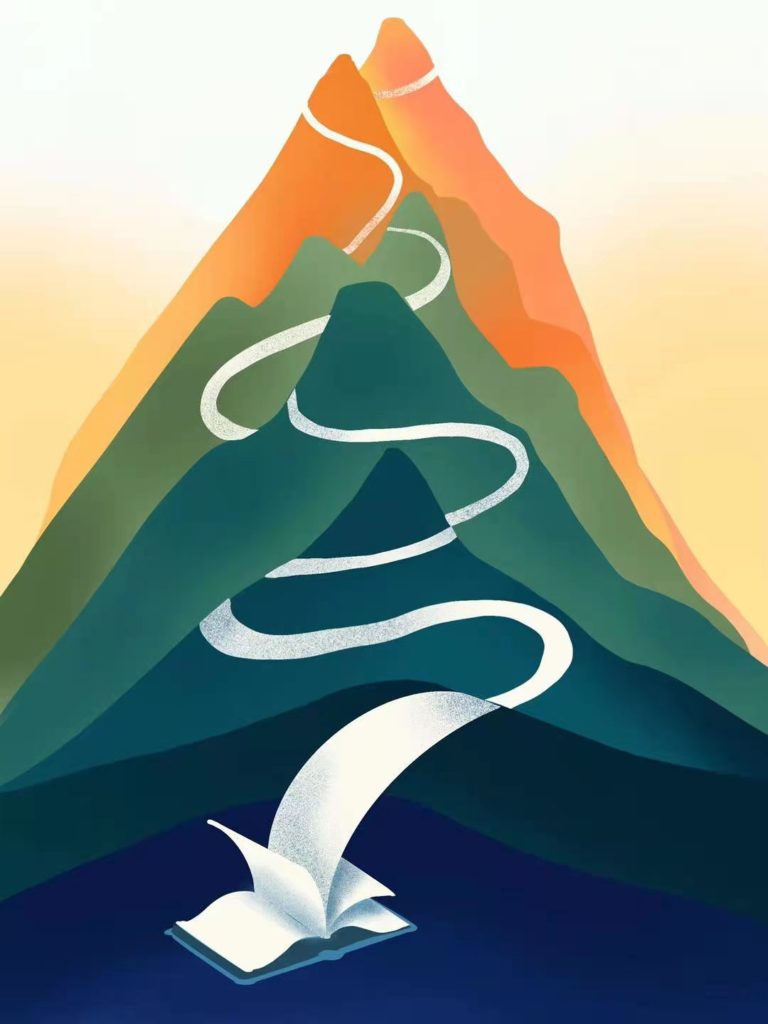
“[It is] difficult to know which part to prefer, when all is equally beautiful and noble.” Weekly Miscellany comments on the poetry of Alexander Pope
Alexander Pope spent his childhood in Windsor forest and, from an early age, gained a keen appreciation for nature. Later in his life he lived in a property by the River Thames in London where he cultivated his own garden that he opened for visitors. In today’s poem, written in 1709, we can see this love of the natural world through his shaping of elements of the landscape into an extended metaphor for knowledge. This landscape is vast and mountainous: the Alps , Europe’s largest mountain range are a prominent feature, as are hills, vales , an endless sky and eternal snows . Compared to this vast landscape, people are almost insignificant. Their role in the poem is to act as explorers who set off on a journey of discovery, trying to conquer the highest mountains by ascending to the summit; we tempt the heights of Arts… the towering Alps we try… Finally, despite being almost exhausted by his efforts, the explorer realises that his journey has barely begun; the mountain vista stretches ahead, unbroken, into the distance:
A poem’s central idea, often developed into an extended metaphor, is known as a conceit . Unlocking the first couplet should provide you the key to Pope’s conceit in An Essay on Criticism . Pope begins with a warning that:
The Pierian Spring is an important place in Greek Mythology , the source of a river of knowledge that was associated with the nine ancient Muses, themselves a metaphor for artistic inspiration. In this poem, it’s part of the landscape that functions as an extended metaphor for learning. It might seem strange that Pope begins by giving his readers a warning to taste not the waters of this river. However, it’s important to realise that Pope isn’t saying not to drink from the well of knowledge at all. He tells us to drink deep , emphasising his instruction with both alliterative D and using the imperative tense (where the verb is placed at the beginning of the line or phrase). To Pope’s mind, learning is seductive and intoxicating . Once you set out on the journey of learning, or take even a tiny sip from the wellspring of knowledge, you won’t be able to resist the temptation to learn more. Therefore, he suggests that you either prepare to immerse yourself completely in the Pierian Spring , or don’t drink at all.
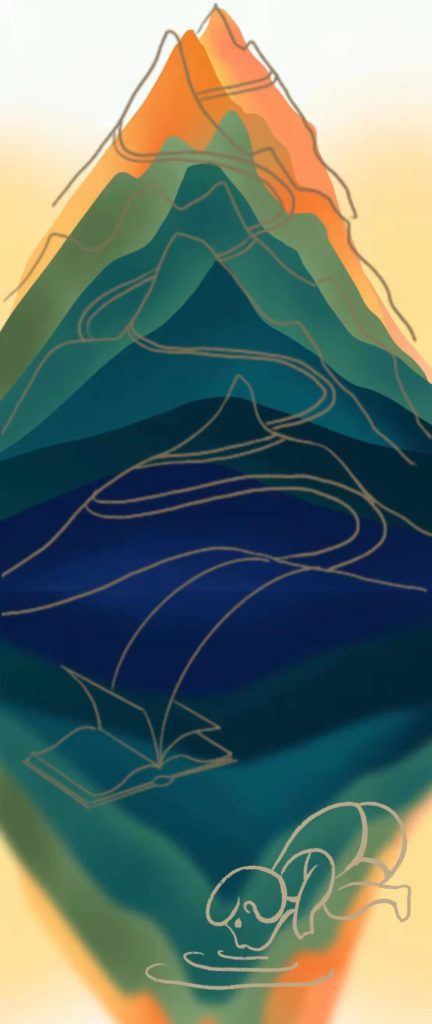
Once you’ve discovered the connotations of Pierian Spring , the rest of the poem can be read as a warning (or criticism ) of anyone who is rash enough not to follow Pope’s instruction. Should you venture unprepared into the unknown, you must be clear about your limitations. As a spring is the starting point of a river, so too is it the starting point of Pope’s extended metaphor . From here, the reader sets out on a journey into an imposing mountainous landscape that, while initially appearing it can be ‘climbed’ or conquered, actually keeps expanding into an endless vista. No matter how far the explorer climbs, the top of the mountain never gets any nearer. Heights, lengthening way, increasing prospect and, most telling of all, eternal snows conjure the visual image of the landscape metaphysically stretching out in front of our weary eyes. Individual people are tiny and easily lost in this ever-shifting world. Pope creates a contrast between the boundless landscape and the bounded limits of human perception. At the last, the human explorer is tired by his efforts to conquer these mountains of knowledge – but the poem ends by revealing that he’d barely even gotten started on his journey: Hills peep o’er hills; Alps upon Alps arise .
Before we get too much further into the discussion of Pope’s ‘essay’, it might be helpful to place these lines in context. Despite the way they seem to be a complete poem in themselves, they are actually part of a much longer poem which stretches to three parts and a total of 744 lines! The eighteen-line extract you’ve read constitutes the second verse of Part 2 and it may help you to know that, in the first verse, Pope singled out pride as the characteristic that would eventually lead to the downfall of his explorer. Here are four lines from earlier in the Essay:
In this short sample, you can see the names Pope calls people who rush off on foolhardy adventures without taking the time to properly prepare: blind man , weak head and fools ! Younger readers might not enjoy this interpretation, but Pope finds the overconfidence of young people most problematic, associating youth with a kind of recklessness that, in hindsight, is misplaced.
You may argue that qualities such as fearless and passionate (fired) seem like compliments; but I detect a note of criticism in Pope’s words; he suggests that young people confuse emotion with clear thinking and they are too eager to plunge into the unknown. There’s an emphasis on speed and rashness ( pleased at first; at first sight ) that cannot last, like a novice marathon runner who goes sprinting out of the blocks while older, more wily competitors know to save themselves for the challenges ahead. While the young explorer does encounter some early success (implied by words like mount , more advanced , attained and, more significantly by an image : tread the sky ), the race is longer than the runner thought and inevitably the pace must sag. Later in the poem, positive diction disappears and words like trembling , growing labours , and tired take over as the true scale of the challenge becomes apparent. Sharp-eyed readers will already have noticed that the image of ‘treading the sky’ was in fact a simile : seem to tread the sky. Subtly, Pope’s use of a simile implies that any success the explorer thought he’d achieved wasn’t actually real.

The implication that over-enthusiasm can cloud good judgment can be traced through diction to do with looking and seeing: a t first sight, short views, see, behold, appear, survey, eyes and peep pepper the poem and convey the poet’s belief that, to our detriment, we can be short-sighted and tunnel-visioned. The eighth line of the poem is entirely concerned with this idea: short views we take, nor see the lengths behind paints a picture of a young explorer who only looks in one direction – eyes fixed straight ahead – and so misses the bigger picture.
While the poem is certainly didactic (it’s trying to impart a lesson), Pope’s tone of voice is not too condescending or stand-offish because he includes himself in his criticism as well. Throughout the poem the words us, we and our soften his accusations so there’s never a ‘them-and-us’ divide between young and old. In fact, Pope was only 21 years old when he finished his Essay on Criticism , so use your mind’s ear to imagine him speaking ruefully from experience, rather than as a nagging or pestering adult complaining about ‘young people today.’ The line Fired at first sight by what the Muse imparts is revealing in this regard. Alluding to the nine Muses of Greek mythology , this line personifies poetic inspiration, so in one sense the extended metaphor of trying to conquer an unknowable landscape represents his own experiences of writing poetry. ‘Meta-poems’ (poems about the writing of poems) actually have a name: ars poetica . Pope implies that rushing off on a path of artistic endeavour without realising the true extent of the commitment that entails is a mistake that he himself has made in his own attempts at writing.
If you’re a student reading this who thinks you might be able to use Pope’s poem as an excuse not to do your homework or give up on your own writing: you shouldn’t be too rash. Pope’s not suggesting we should quit. Instead, he’s warning us that what might seem like a shallow pool is in fact a deep river of knowledge. Once you jump in, the current will sweep you away and there’s no going back. The poem is a criticism of unpreparedness and arrogance rather than an acknowledgement of futility. In fact, an element of form suggests that, for all the faults Pope has pointed out in young people who are too confident in their limited abilities, it is much more praiseworthy to try and fail to conquer the heights than never to try at all. The poem is written in iambic pentameter that is constant and regular as if, no matter how tough the going gets, the young explorer doesn’t give up. Compare these two lines, with iambic accents marked, from the beginning and end of the poem to see how the rhythm is unfailing:
More, the poem is arranged in rhyming couplets (the rhyme scheme is AA, BB, CC and so on). Rhyming couplets written in iambic pentameter are traditionally known by a more dramatic name: heroic couplets . Pope was widely considered to be the master of writing poetry in heroic couplets ; using them here implies that Pope ultimately believes any young person who’s brave – or foolhardy – enough to embark upon the lifelong journey of learning is worthy of praise.
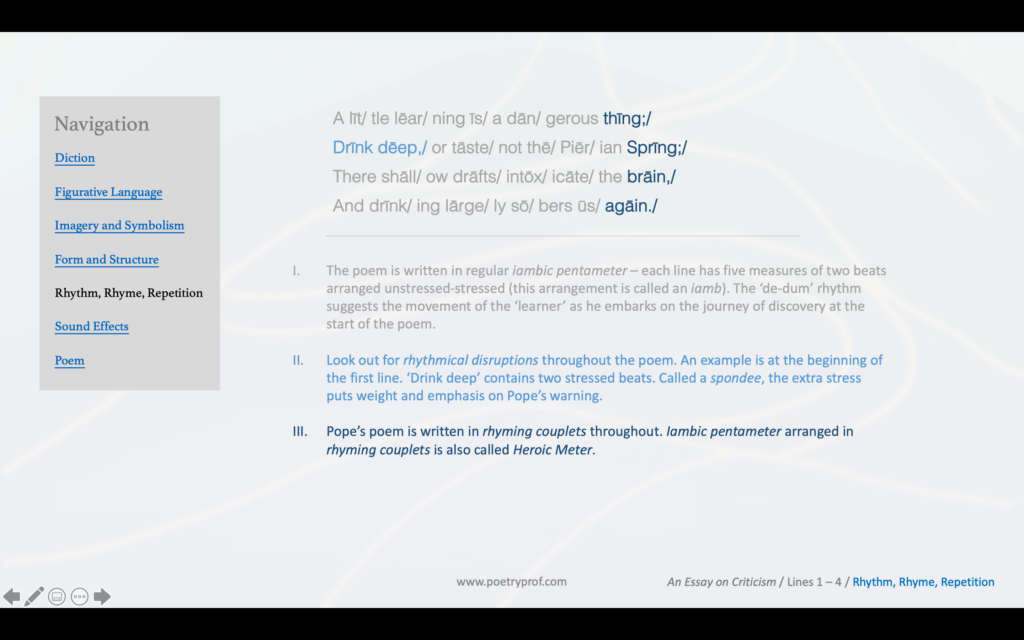
The structure of Pope’s poetical essay matches the message he’s trying to convey – that, once you start learning, you won’t be able to stop. Look carefully at the punctuation marks, in particular his use of full stops . You’ll find the first one at the end of the fourth line, the second after the tenth and the third at the end of the poem (after eighteen lines). In other words, if the poem was arranged in verses, the first verse would be nice and short at only four lines, the second would stretch to six, but the final verse would have doubled in length to eight lines. Expanding sentences represent the conceit – a little learning is a dangerous thing – and match the images of the landscape expanding ( eternal snows , increasing prospect, lengthening way ) as you read further down the poem.
The end of the poem brings Pope’s criticism to its conclusion. We see the young explorer break through the eternal snows , climb above the clouds, and stand triumphantly on the mountain top, proudly surveying his achievements. Only now does he take a moment to look more deliberately at the mountains he’s trying to conquer:
Be alert to two words that might seem insignificant: appear and seem , words that signal the mistake the explorer made; he thought that he had already past the bulk of his journey. Read carefully to punctuation as well, and you’ll see the colon – a longer pause, which creates a caseura – representing the traveler pausing at the moment of his triumph… and it’s here that realisation finally dawns. Despite the difficulty of his climb thus far, the landscape ( increasing prospect ) stretches out endlessly in front of him: Hills peep o’er hills, and Alps on Alps arise . Here, repetition mixes with all that increasing and lengthening diction to create a surreal image of an ever-expanding landscape stretching out ahead. You might also notice P sounds peppering the last two lines of the poem in the words p ee p , Al p s, Al p s, and p ros p ect . Coming from a category of alliteration called plosive , this sound is excellent at conveying a release of negative emotion, as it is formed by pushing air through closed lips. The sound helps us perceive the taste of victory turning to defeat as the weary traveler’s shoulders slump at the prospect of the endless climb still to come.
What does Pope offer as a solution? He already warned us at the start of the poem: drinking largely sobers us again . Suddenly, the importance of the word sober becomes clear. While the idea of heading off on this journey of discovery was intoxicating , firing up those with passion to learn, discover and explore – the reality is very different. That young, over-confident learner/explorer is gone, replaced by a wiser, but more world-weary traveler who can finally see the true scale of the task ahead. By now it’s too late, he’s stuck on the mountain top and there’s only one thing he can do – go onwards!
So drink deep and be prepared to encounter much more than you expected when you set out on your journey.

Suggested poems for comparison:
- from Essay on Man by Alexander Pope
An Essay on Criticism was not the only poetical essay written by Pope. French writer Voltaire so admired Pope’s Essay on Man that he arranged for its translation into French and from there it spread around Europe.
- Marrysong by Dennis Scott
As in Pope’s poem, Scott creates a metaphor of the landscape to represent his marriage. He is an explorer in a strange land – each time the explorer glances up from his map, the landscape has changed and he’s lost again.
- Through the Dark Sod – As Education by Emily Dickinson
Victorians brought many different associations to all kinds of plants and flowers. In this Emily Dickinson poem, the lily represents beauty, purity and rebirth. This link will also take you to a fantastic blog which aims to read and provide comment on all of Emily Dickinson’s poems. So that’s 1 down, and nearly 2000 more to go…
- In the Mountains by Wang Wei
Often spoken of with the same reverence as Li Bai and Du Fu, Wang Wei is a famous imagist poet in China. In these exquisite portrait poems, Wang Wei paints pictures of the impressive landscapes of his mountain home.
Additional Resources
If you are teaching or studying An Essay on Criticism at school or college, or if you simply enjoyed this analysis of the poem and would like to discover more, you might like to purchase our bespoke study bundle for this poem. It costs only £2 and includes:
- Study Questions with guidance on how to answer in full paragraphs;
- A sample analytical paragraph for essay writing;
- An interactive and editable powerpoint, giving line-by-line analysis of all the poetic and technical features of the poem;
- An in-depth worksheet with a focus on analysing diction and explaining lexical fields ;
- A fun crossword quiz, perfect for a starter activity, revision or a recap;
- A four-page activity booklet that can be printed and folded into a handout – ideal for self study or revision;
- 4 practice Essay Questions – and one complete model Essay Plan.
And… discuss!
Did you enjoy this analysis of Alexander Pope’s Essay on Criticism ? Do you agree that the poem somewhat singles out young people? Can you relate to Pope’s messages about the temptations of learning? Why not share your ideas, ask a question, or leave a comment for others to read below. For nuggets of analysis and all-new illustrations, find and follow Poetry Prof on Instagram.
Leave a Reply Cancel reply
Your email address will not be published. Required fields are marked *
Notify me of follow-up comments by email.
Notify me of new posts by email.

- My presentations
Auth with social network:
Download presentation
We think you have liked this presentation. If you wish to download it, please recommend it to your friends in any social system. Share buttons are a little bit lower. Thank you!
Presentation is loading. Please wait.
An Essay on Criticism Alexander Pope.
Published by Sheila Black Modified over 5 years ago
Similar presentations
Presentation on theme: "An Essay on Criticism Alexander Pope."— Presentation transcript:
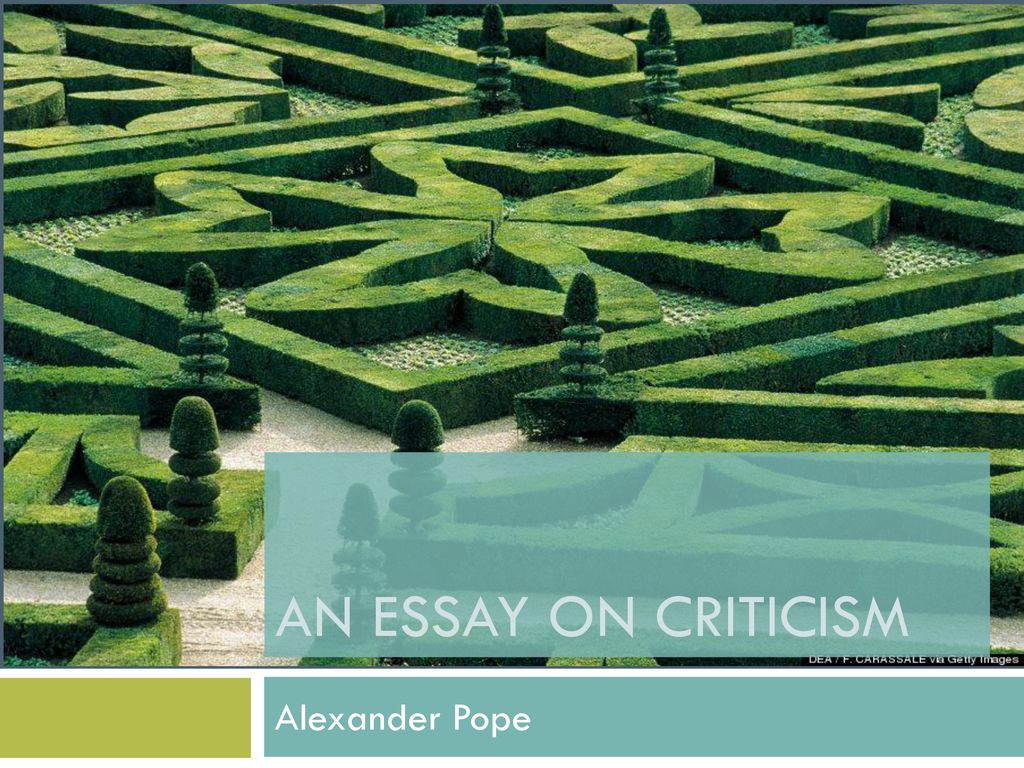
Jonathon Swift & British Society in 18 th Century.

The Rise of the Novel Defoe and Swift. Dates 1660: Restoration of Charles II 1666: the Great Fire of London 1685: accession of James II : the Glorious.

Alexander Pope Notes. “For fools rush in where angels fear to tread.” ---Alexander Pope “I never wonder to see men wicked, but I often wonder to see them.

Gulliver’s Travels & Modest Proposal

“ Our deeds determine us as much as we determine our deeds.” Eliot (1819 – 1880)

An 18 th Century movement which followed after the mysticism, religion and superstition of the middle ages. The neoclassical age came after the Renaissance.

Jonathan Swift Kathy Schafer Application #4. Jonathan Swift ~ His Life born in Dublin, Ireland educated at Trinity College in Dublin ( ), receiving.

Shakespeare His Life and Works Early Years Born on April 23 rd, 1564 in Stratford-upon-Avon Father, named John was a glove maker and a politician.

By Zhu Xiangjun. Bible Unit 6 Gulliver’s Travels.

Jonathan Swift Contents 1. Life2. Works 3. Achievements 4. The story of Gulliver's Travels

Roman Catholic Could not vote inherit or purchase land attend a public school or university live within ten miles of London hold.

Gulliver’s Travels by Jonathan Swift

Unit 3 Age of Reason British Literature Ms. Carroll.

Jonathan Swift: Born in Dublin, Ireland. At 19, he was employed by Sir William Temple, a powerful English statesman. Tutored 8-year-old Esther.

Jonathan Swift and “A Modest Proposal” Swift was born in Dublin in Swift was born into the Anglo-Irish ruling class. He joined the Anglican Church.

Jonathan Swift “A Modest Proposal” Gulliver’s Travels

Gulliver’s Travels By Jonathan Swift.

Born Nov. 30, 1667 in Dublin, Ireland Began education at Kilkenny Grammar School in 1673 Attended Trinity College Received M.A. from.

Jonathan Swift By: Phillip Norselli. Early life Born November In Dublin Ireland Father was a lawyer Unexpectedly died a few months before he was.

The French novelist Jules Verne was the first authentic exponent of modern science fiction.
About project
© 2024 SlidePlayer.com Inc. All rights reserved.

IMAGES
VIDEO
COMMENTS
An Essay on Criticism Structure Written in heroic couplets. Written in the Horatian mode. Concerned with the writers and critics behave in the new literary commerce. Covers a range of good criticism and advice. Represents many of the chief literary ideals of Pope's age. It is divided into 3 parts: thesis, antithesis, and synthesis.
Alexander Pope's "An Essay on Criticism" seeks to lay down rules of good taste in poetry criticism, and in poetry itself. Structured as an essay in rhyming verse, it offers advice to the aspiring critic while satirizing amateurish criticism and poetry. The famous passage beginning "A little learning is a dangerous thing" advises would-be ...
An Essay on Criticism (1711) was Pope’s first independent work, published anonymously through an obscure bookseller [12–13]. Its implicit claim to authority is not based on a lifetime’s creative work or a prestigious commission but, riskily, on the skill and argument of the poem alone. It offers a sort of master-class not only in doing….
An Essay on Criticism, published anonymously by Alexander Pope (1688–1744) in 1711, is perhaps the clearest statement of neoclassical principles in any language. In its broad outlines, it expresses a worldview which synthesizes elements of a Roman Catholic outlook with classical aesthetic principles and with deism.
A poem’s central idea, often developed into an extended metaphor, is known as a conceit. Unlocking the first couplet should provide you the key to Pope’s conceit in An Essay on Criticism. Pope begins with a warning that: A little learning is a dangerous thing; Drink deep, or taste not the Pierian Spring: The Pierian Spring is an important ...
Pope primarily used the heroic couplet, and his lines are immensely quotable; from “An Essay on Criticism” come famous phrases such as “To err is human; to forgive, divine,” “A little learning is a dang’rous thing,” and “For fools rush in where angels fear to tread.”. After 1718 Pope lived on his five-acre property at ...
About the Title. "An Essay on Criticism" is in the form of a rhyming poem, but its content is akin to a nonfiction essay detailing and supporting Pope's arguments about writers and critics. Alexander Pope wrote and translated many different types of literature, using poetic forms to express diverse content.
An Essay on Criticism, didactic poem in heroic couplets by Alexander Pope, first published anonymously in 1711 when the author was 22 years old. Although inspired by Horace ’s Ars poetica, this work of literary criticism borrowed from the writers of the Augustan Age. In it Pope set out poetic rules, a Neoclassical compendium of maxims, with a ...
An Essay on Criticism: Part 1. By Alexander Pope. Si quid novisti rectius istis, Candidus imperti; si non, his utere mecum. [If you have come to know any precept more correct than these, share it with me, brilliant one; if not, use these with me] (Horace, Epistle I.6.67) PART 1. 'Tis hard to say, if greater want of skill.
15 Swift befriended Alexander Pope, and he visited Pope twice in England On the second visit, Pope help Swift publish his new book, Gulliver’s Travels, which was immensely popular Swift returned to Ireland; the last years of his life were very difficult He lost several close friends, suffered from mental illness (probably the result of a stroke), and even refused to speak for the term of a ...